Bhushan B. Nanotribology and Nanomechanics: An Introduction
Подождите немного. Документ загружается.

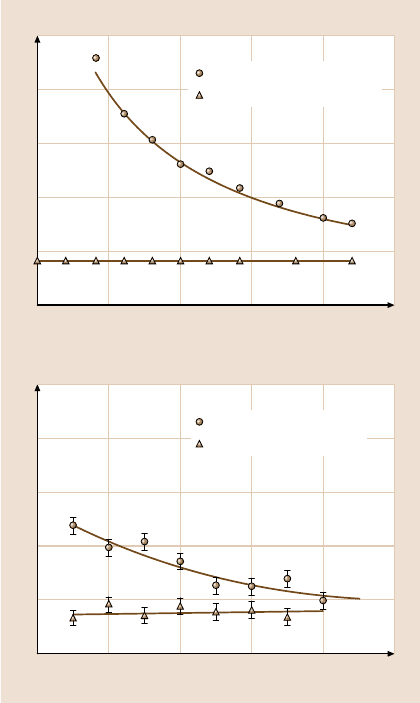
13 Computer Simulations of Nanometer-Scale Indentation and Friction 717
200
0
Number of water molecules
Friction coefficient
250 300 350 400 450
0.2
0.4
0.6
0.8
1.0
a)
Hydrophilic (OH/CH
3
)
Hydrophobic (CH
3
)
0
0
Relative humidity
Friction coefficient
20 40 60 80 100
0.2
0.4
0.6
0.8
1.0
b)
Hydrophilic (COOH)
Hydrophobic (CH
3
)
Fig. 13.63. (a) Friction co-
efficients for hydrophobic
(−CH
3
) and hydrophilic (50%
mixed −CH
3
/ −OH) mono-
layers as a function of water
molecules from MD simu-
lations at 300 K (H = 6.0Å),
and (b) scanning force mi-
croscopy measurements of
frictional forces of difference
surfaces under various rela-
tive humidities. After [248]
with the permission of the
AIP (2005)
separationdistance decreaseas thechain lengthincreases from6 to18 carbon atoms.
However,the friction forces are independentof the chain length and the shear veloc-
ity. The system size is shown to have an effect on the sharpness of the slip transitions
but not on the dynamical events, as shown in Fig. 13.67.
In short, atomic-scale simulations show the relationship between elastic prop-
erties, degree of molecular disorder and friction of self-assembled thin films that
illuminates the origin of the properties that are measured experimentally.
Nanoparticles
Nanoparticles are being considered for a wide variety of applications, including as
fillers for nanocomposite materials, novel catalysts or catalytic supports, and com-
ponentsfor nanometer-scaleelectronicdevices[252].They havealso generatedcon-
siderable interest as possible new lubricant materials that have the potential to func-
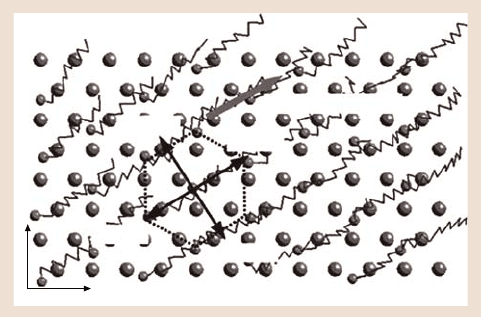
718 Susan B. Sinnott et al.
y
x
è=180°
Chain tilt direction
è=270°
è=90°
è=0°
Fig. 13.64. Schematic illustration of the chain tilt and scan directions on alkanethiol
SAMs/Au(111) in hybrid molecular simulations; θ is the angle between the tip moving di-
rection and the chain tilt direction. The larger spheres represent substrate Au atoms, smaller
spheres sulfur atoms in molecular chains, and zigzag lines molecular chains. After [249] with
the permission of the ACS (2003)
tionas “nanoballbearings”with exceptionallylowfrictioncoefficients.Thenanopar-
ticles of most interest for tribological applications include C
60
[253–265], carbon
nanotubes [266–273], and MoO
3
nanoparticles [274,275], among others [276].
The experiments report wide variations in frictional coefficients (for instance,
values of 0.06 to 0.9 have been measured for C
60
) that may be caused by differ-
ences in the experimental methods used, the thickness of the nanoparticle layer or
island,the atmosphere(argonversus air, levels of humidity)used,and the transfer of
nanoparticles to the FFM tips. As a result, there is much that remains to be clarified
about the tribological behavior of nanoparticle films.
In the case of C
60
, the mechanistic response to applied shear forces has not
been definitively determined. For example, some experimental studies show evi-
dence of C
60
molecules rolling against the substrate, each other, or the sliding sur-
faces [253,258,260,263,265]while others hypothesize that the low friction of C
60
films is due in part to blunting of the tip by transfer of fullerene molecules to the
tip apex. Fullerene films are found experimentally to have dissipation energies and
shear strengths that are a full order of magnitude lower than the values that are
typical for boundary lubricants [277]. Experimental testing of the frictional proper-
ties of fullerenes reveal low mechanical stability accompanied by progressive wear
and transfer of fullerene materials when they are only physisorbed on a solid sur-
face [278]. Furthermore, measurements with a FFM show that under certain condi-
tions,adsorbedfullerenefilmsdeteriorateatpressuresas lowas about0.1GPa[279].
The challenge is therefore to obtain mechanically stable, ordered molecular films of
fullerenes firmly attached to a solid substrate.
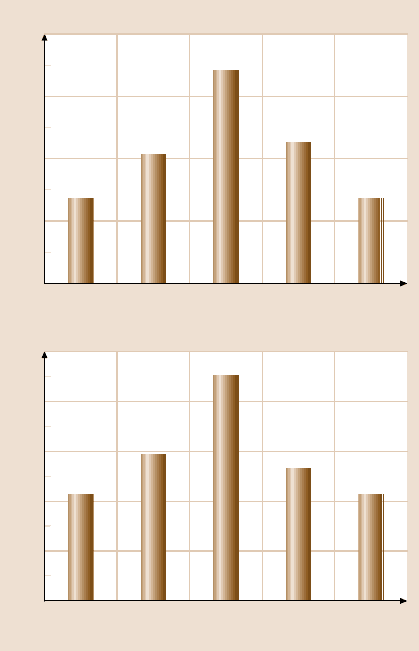
13 Computer Simulations of Nanometer-Scale Indentation and Friction 719
0
0
Scan direction è (deg)
Frictional force (nN)
a)
0.05
0.1
0.15
0.2
300K
90 180 270 360
0
0
Scan direction è (deg)
Frictional force (nN)
b)
0.20
1
1.0K
90 180 270 360
0.40
0.60
0.80
Fig. 13.65. Frictional force as
a function of scan direction
from hybrid simulations for
C
11
CH
3
SAMs on Au(111)
at (a) 300 K and (b)1.0K.
Frictional force is the small-
est when scanned along the
tilt direction, the largest when
scanned against the tilt di-
rection, and between when
scanned perpendicular to the
tilt direction at both temp-
eratures. After [249] with the
permission of the ACS (2003)
There have been several MD simulation studies to investigate the tribological
properties of fullerenes. A representative study by Legoas et al. [280] investigated
the experimentally observed low-friction system of C
60
molecules positioned on
highly oriented pyrolytic graphite. The results show that decreasing the van der
Waals interaction between a C
60
monolayer and graphite sheets, and the charac-
teristic movements of graphite flakes over C
60
monolayers, explains the measured
ultralow friction of C
60
molecules and graphite sheets.
Several MD simulation studies have also been carried out on the tribological
properties of carbon nanotubes. For example, simulations by Buldum et al. and
Schall et al. [266, 269] indicate that single-wall carbon nanotubes roll when their
honeycomb lattice is “in registry” with the honeycomb lattice of the graphite. If
this registry is not present, the carbon nanotubes respond to applied forces from
an AFM by sliding. This behavior is nicely summarized in Fig. 13.68. These MD
simulationfindingswere simultaneouslyconfirmedin experimentalstudiesby Falvo
et al. [268]. Experimental studies of multiwall carbon nanotubes on graphite [272]
show similar evidence of nanotube rolling when the outer tube is pushed.
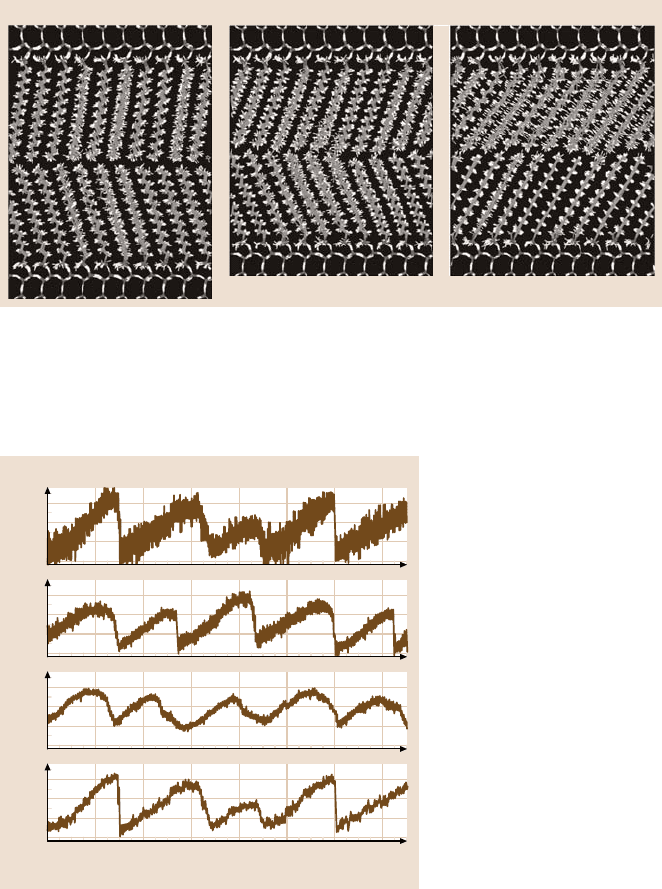
720 Susan B. Sinnott et al.
a) b) c)
Fig. 13.66. Wireframe images of n = 18 SAMs at fixed separations of (a) d = −5.2Å(low
pressure, under compression only) (b) d = −10.2 Å (high pressure, under compression only)
and (c) d = −10.2 Å (high pressure, under shear). After [251] with the permission of the ACS
(2005)
0
250
Distance (Å)
Shear stress (MPa)
0
250
500
142 4 6 8 10 12
d)
250
0
250
500
c)
250
0
250
500
b)
250
0
250
500
a)
Fig. 13.67a–d. Shear stress
σ
s
as a function of system size
for n = 6 SAMs correspond-
ing to a pressure of 200 MPa
at v = 1.0m/s: (a) 100 chains
per surface, (b) 400 chains
per surface, (c) 1600 chains
per surface, and (d) 16 point
box average of system with
100 chains per surface. Af-
ter [251] with the permission
of the ACS (2002)
The tribological properties of nanotube bundles are important, as it is well-
known that carbonnanotubes agglomeratetogether veryreadily to form bundles and
are often grown in bundle form [252]. An experimental study by Miura et al. [273]
of carbon nanotube bundles being pushed around on a KCl surface with an AFM
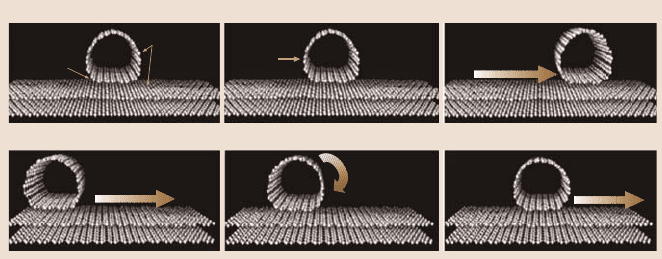
13 Computer Simulations of Nanometer-Scale Indentation and Friction 721
Slide
Roll
Slide
Slide
Graphite
substrate
Bond order
Lennard-Jones
(612)
(10,10) nanotube
Impulse
In registry slide
Out of registry slide-r
oll-slide
Fig. 13.68. Dynamics of a nanotube on a graphite surface. When the nanotube and graphite
plane are out of registry, the nanotube slides as it slows down from an initial impulse (upper
right panel). When the nanotube is oriented such that it is in registry with the graphite, it
slows by a combination of rolling and sliding
tip indicates that bundles of single-wall carbon nanotubes can be induced to roll in
a manner that is similar to the rolling observed for multiwall nanotubes.
MD simulations by Ni et al. [270, 271] considered the responses of horizon-
tally and vertically aligned single-wall carbon nanotubes between two hydrogen-
terminated diamond surfaces, where the top surface is slid relative to the bottom
surface. The movementof the carbon nanotubes in response to the shear forces was
predicted to be simple sliding for both orientations. Interestingly, the simulations do
not predict rolling of the horizontally arranged carbon nanotubes even when they
are aligned with each other in two-layer and three-layer structures. Instead, at low
compressive forces, illustrated in Fig. 13.69, the nanotube bundles slide as a single
unit, and at high compressive forces, also illustrated in Fig. 13.69, the deformed
carbon nanotubes closest to the topmost moving diamond surface start to slide in
a motion reminiscent of the movement of a tank or bulldozer wheel belt. However,
when these moving carbon nanotube atoms would have turned the first corner at the
top of the ellipse, they encounter the neighboring nanotube and cannot slide past it.
This causes them to deform even further, form cross-links with one another, and,
in some cases, move in the reverse direction to the sliding motion of the diamond
surface. This causes the large oscillations in the normal and lateral forces plotted in
Fig. 13.69.
The responses of the horizontally arranged carbon nanotubes are substantially
different from the responses of the vertically arranged nanotubes at high compres-
sion, as can be seen by comparing Figs. 13.69 and 13.70. The vertical, capped car-
bon nanotubes are quite flexible and bend and buckle in response to applied forces.
As the buckle is forming, the normal force decreases then stabilizes in the buck-
led structure, as illustrated in Fig. 13.70. As the topmost diamond surface slides,
the buckled nanotubes swing around the buckle “neck” which helps dissipate the
applied stresses. For this reason, the magnitudes of the lateral forces are not signifi-
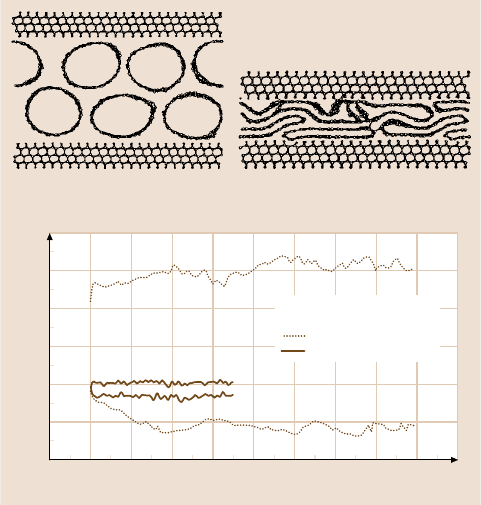
722 Susan B. Sinnott et al.
2.5
200
Displacement (Å)
Force (nN)
100
0
100
200
300
400
22.50 2.5 5 7.5 10 12.5 15 17.5 20
1
2
1
2
1 = Normal force
2 = Lateral force
No ompression
Compression 13.7 GPa
a) b)
Fig. 13.69. Top: Snapshots from simulations that examine the sliding of the topmost diamond
surface on horizontally arranged nanotubes at different compressions; (a) is at a pressure of ≈
0GPa;(b) is with a pressure of 13.7GPa.Bottom: Plots of the normal and lateral components
of force during sliding of the top diamond’s surface on horizontally arranged nanotubes as
a function of the displacement of the top diamond surface with respect to the diamond surface
on the bottom
cantly different for the vertical nanotubes at low and high compression, as indicated
in Fig. 13.70.
When the ratio of the frictional (lateral) force to the normal force is taken to
calculate friction coefficients for these systems, high, nonintuitive values were ob-
tained. As outlined by Ni et al. [270], this is because the actual contact area of the
nanotubesis not proportionalto the sliding force. In the case of the horizontal nano-
tube bundles, the tubes are able to deform and significantly change their contact
area with the sliding surface with minimal change in the normal force, as shown in
Fig. 13.69. In the case of the vertical nanotubes, the contact area remains approxi-
mately the same regardless of the initial loading force because of the flexibility of
the nanotubes. This causes the lateral forces to change only slightly with significant
changes in the normal force, as shown in Fig. 13.70. This analysis indicates that
care must be taken in calculating friction coefficients for nanotube systems. Recent
experiments by Dickrell et al. [281] show good agreement with these predictions, as
shown in Fig. 13.71.
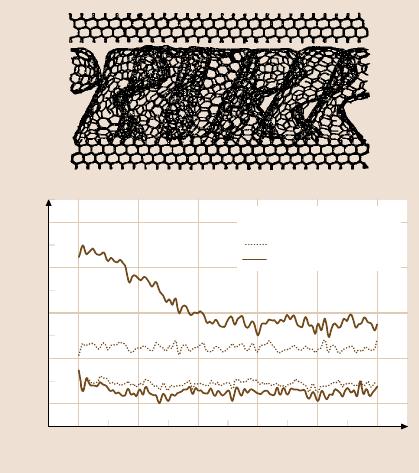
13 Computer Simulations of Nanometer-Scale Indentation and Friction 723
Displacement (Å)
Force (nN)
100
0
100
200
300
0 5 10 15 20 25
1 = Normal force
2 = Lateral force
Compression 1.44 GPa
Compression 11.5 GPa
1
1
2
2
Fig. 13.70. Top: Snapshots
from simulations that exam-
ine the sliding of the topmost
diamond surface on vertically
arranged nanotubes with one
set of capped ends compressed
at a pressure of 11.5GPa.Bot-
tom: Plots of the normal and
lateral components of force
during sliding of the top dia-
mond’s surface on vertically
arranged nanotubes as a func-
tion of the displacement of
the top diamond surface with
respect to the diamond surface
on the bottom
To summarize, this section shows that nanoparticles show some promise as lu-
bricating materials due to their exceptionallylow friction coefficientsin experiments
and simulations. Some nanopaticles show lattice-directed sliding on substrates due
to their unique atomic structures. However, there is much that remains to be done
before the nanometer-scale friction of these materials is well understood.
Solid State
Surfaces are able to slide over eachother at highloads with a minimum of resistance
from friction in the presence of liquid lubricants. Some solid thin films can also ful-
fill these functions and, when they do, are termed solid lubricants. Solid lubricants
are generally defined as having friction coefficients of 0.3 or less and low wear.
Bowden and Tabor showed how thin solid films can reduce friction as fol-
lows [283]. The total friction force F
f
is given as
F
f
= AF
S
+ F
p
, (13.11)
where F
p
is the plowing term, A is the area of contact and F
S
is the shear strength of
the interface. If the surfaces are soft, F
S
will be reduced while the other parameters
will increase. However, if the surfaces under the solid film are very stiff, A and F
p
will decrease thereby decreasing friction. The properties specific to the film will
also have an effect on friction. For instance, if the films are less than 1 µmthick,
the surface asperities will be able to break through the film to eventually cause wear
between thesurfacesunder normalcircumstances.On the otherhand, if the lubricant
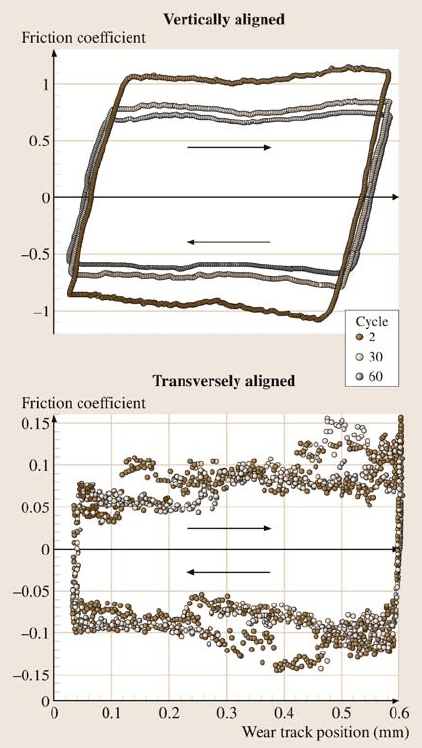
724 Susan B. Sinnott et al.
Fig. 13.71. Coefficient of
friction data versus track
position collected for one
full cycle of reciprocating
sliding for nanotubes that are
vertically and transversely
aligned. After [281]
film is too thick, there will be increased plowing and wear that causes the frictional
forces to increase. It is important that the lubricant not delaminate in response to the
frictional forces, so strong bonds between the lubricant and the surface are required
for a solid state lubricant to be effective.
The most common materials used as solid lubricants have layered structures
like graphite or MoS
2
, that, as discussed above, experience low friction. It is not
necessary for the lubricant film to have a layered structure to give low friction. For
example, diamond-like carbon has some of the lowest coefficients of friction meas-
ured and yet does not have a layered structure. Similarly, not all layered structures
are lubricants. For instance, mica gives a relatively high coefficient of friction (> 1).
The atomic-scale tribological behavior that occurs when a hydrogen-terminated
diamond (111) counterface is in sliding contact with amorphous, hydrogen-free,
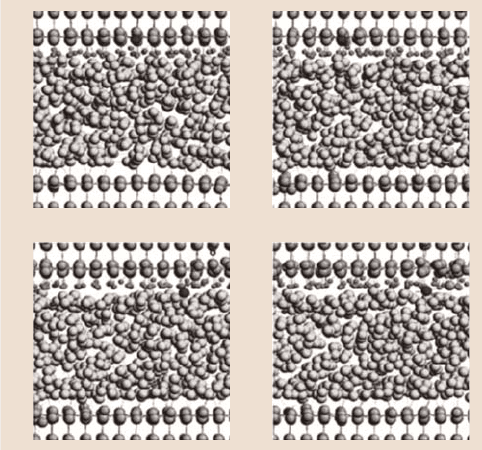
13 Computer Simulations of Nanometer-Scale Indentation and Friction 725
DLC films was examined using MD simulations by Gao et al. [282]. Two films,
with approximately the same ratio of sp
3
–sp
2
carbon but different thicknesses, were
examined. Similar average friction was obtained from both films in the load range
examined. A series of tribochemical reactions occur above a critical load that result
in a significant restructuringof the film, which is analogousto the “run-in” observed
in macroscopic friction experiments, and reduces the friction. The contribution of
adhesion between the counterface and the sample to friction is examinedby varying
the saturation of the counterface. The friction increases when the degree of satura-
tion of the diamond counterface is reduced by randomly removing hydrogen atoms.
Lastly, two potential energy functions that differ only in their long-range forces are
used to examine the contribution of long-range interactions to friction in the same
system (as illustrated in Figs. 13.72 and 13.73).
MD simulations were also recently used by Gao et al. [284] to examine the
effects of the sp
2
–sp
3
carbon ratio and surface hydrogen on the mechanical and
tribological properties of amorphous carbon films. This work showed that, in addi-
tiontothesp
2
–sp
3
ratio of carbon, the three-dimensional structures of the films are
a) b)
c) d)
Fig. 13.72a–d. A series of chemical reactions induced by sliding of the counterface over the
thin film under an average load of 300 nN. (a) The sliding causes the rupture of a carbon–
hydrogen bond in the counterface. (b) The hydrogen atom is incorporated into the film and
forms a bond to a carbon atom in the film. (c) A bond is formed between the unsaturated
carbon atoms in the film and the carbon that suffered the bond rupture in the counterface, and
continued sliding causes this carbon to be transferred into the film. (d) The transferred carbon
forms a bond with another carbon in the counterface. The counterface has slid 0.0 (a), 15.9
(b), 26.1 (c), and 30.5Å(d). After [282] with the permission of the ACS (2002)
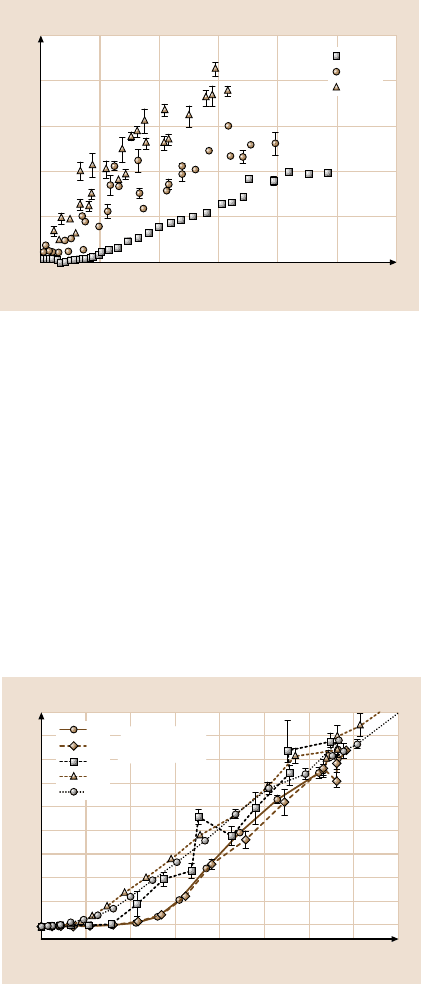
726 Susan B. Sinnott et al.
600
0
Load F
z
(nN)
Friction F
x
(nN)
50
100
150
200
250
5004003002001000
90%
100%
80%
Fig. 13.73. Friction curves
for the thin film system with
a counterface that is 100%
hydrogen-terminated (open
squares), 90% hydrogen-
terminated (filled squares),
and 80% hydrogen-terminated
(open circles). After [282]
with the permission of the
ACS (2002)
important when determining the mechanical properties of the films. For example,
it is possible to have high sp
2
-carbon content, which is normally associated with
softer films, and large elastic constants. This occurs when sp
2
-ringlike structures
are oriented perpendicular to the compression direction. The layered nature of the
amorphous films examined leads to novel mechanical behavior that influences the
shape of the friction versus load data, as illustrated in Fig. 13.74. When load is ap-
plied to the films, the film layer closest to the interface is compressed. This results in
the very low friction of films I and II up to approximately 300 nN and the response
of films IV and V up to 100 nN. Once the outer film layers have been compressed,
additional application of load causes an almost linear increase in friction for films I
and II as well as IV and V. Film III has an erratic friction versus load response due
to the early onset of tribochemical reactions between the tip and the film.
0
0
Load F
z
(nN)
Friction F
x
(nN)
20
40
60
80
100
120
140
160
180
800100 200 300 400 500 600 700
I
II
III
IV
V
Amorphous
carbon films
Fig. 13.74. Average friction
versus load for five amor-
phous carbon films. Films
I–III are hydrogen-free and
contain various ratios of sp
2
-
to-sp
3
carbon. Films IV and V
are both over 90% sp
3
carbon
and have surface hydrogena-
tion
